Table of contents
- Solutions and alternatives for scratched surfaces Powder coating and painting
- Structural change during chrome plating
- Outdated prejudice
- Thorough preparation when powdering is crucial
- Spatulas and fillers are taboo
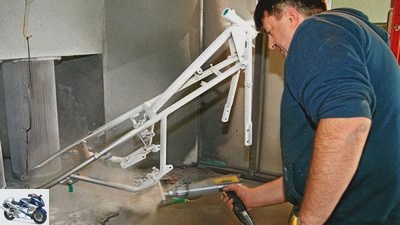
Schoch
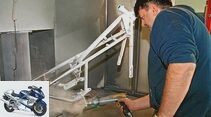
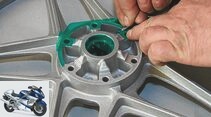
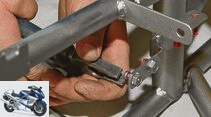
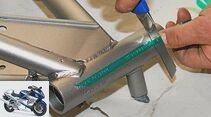
11 pictures
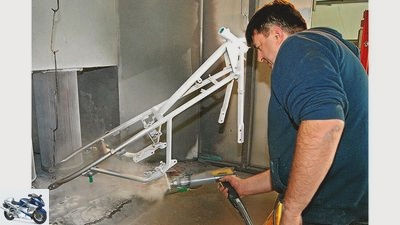
Schoch
1/11
Powder coating or painting? Once the paint is off, a solution is needed.
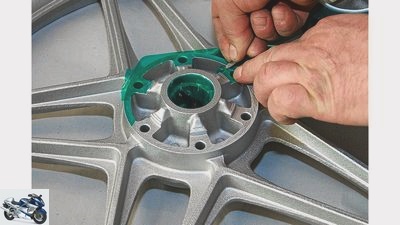
Schoch
2/11
Masking the brake disc flange on the front wheel is quite a fiddly and time-consuming job.

Schoch
3/11
In the case of continuous threads, screws must be screwed in before coating, but these must not protrude at the thread exit.
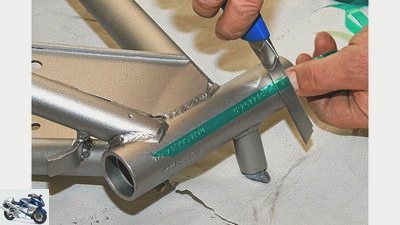
Schoch
4/11
Preparatory work: The frame number must be masked off, otherwise it will disappear under the coating. The adhesive strip is peeled off in the powder state after the work has been completed, this area is then only lightly “powdered”.
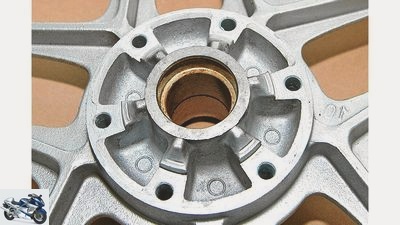
Schoch
5/11
Tip: To protect against the blasting material, it is advisable to leave the old wheel bearings in the bearing seat and only then to remove them.
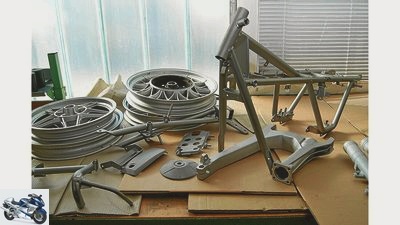
Schoch
6/11
Blank: After sandblasting, a thorough wash is due. Blasting dust and sand residues have to go down.

Schoch
7/11
Meticulous care is also required when taping the friction surfaces of a drum brake precisely.
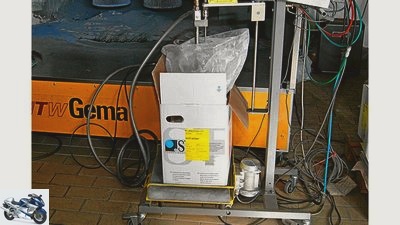
Schoch
8/11
Cardboard instead of can: The powder, available in various RAL colors, is sucked out of a cardboard box.

Schoch
9/11
Right: The electrostatically charged powder particles are automatically attracted to the metal.
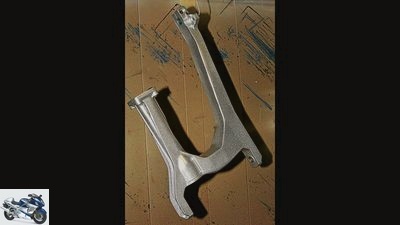
Schoch
10/11
After the parts have “burned”, a short cooling phase is sufficient, and they can then be installed immediately.
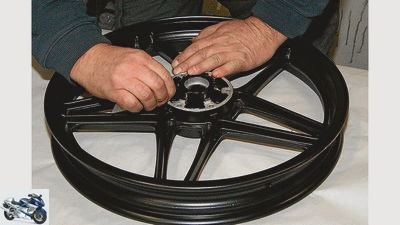
Schoch
11/11
Josip Barbir removes the masking tape while it is still hot. Now it’s soft and easy to peel off. The shiny impression disappears after cooling, then this Guzzi rim shows the desired matt black.
counselor
workshop
Powder coating and painting
Solutions and alternatives for scratched surfaces
Powder coating and painting
Content of
If the paint is off, scratched or surfaces have become dull, a paint gun is often used or electroplated, whatever it takes. Not only does both cost a lot of money, in many cases paintwork and galvanic coatings are not feasible or durable enough for technical reasons. Powder coating is a real alternative here.
Marcel Schoch
04/17/2013
Surface coatings – lacquer or a galvanic application are nothing else – have to fulfill two tasks. On the one hand, they should protect the component from corrosion, and on the other hand, they should create an attractive surface. Of course, the whole thing should last as long as possible – but this is where the problems start.
For example, paints on parts that are dynamically or statically highly stressed, such as shock absorber springs, rims, chassis components or frames, can look old after just a few months, as sooner or later they become brittle after hardening. Consequence: The expensive and laboriously applied paint is damaged by stone chips or the effects of the weather. What begins with small flakes sooner or later leads to corrosion of the metal underneath. Then it has to be painted again.
Structural change during chrome plating
Electroplated coatings, commonly known as chrome plating, are more durable and usually last for many years. But they have one major disadvantage. In particular, parts that are subject to high mechanical loads must not be galvanically treated because the surface treatment (polishing) and the applied galvanic layer have changed the tensile and fracture behavior compared to the untreated part. The material expert speaks of a structural change here. Most testing organizations therefore categorically reject galvanically revised components in the chassis or brake area, refuse approval or the test seal.
At this point at the latest, many people begin to consider whether there are alternatives to permanently seal or beautify surfaces. The solution, which is mentioned here more and more often, is powder coating. Although this method has been used successfully for many years in the industry in a wide variety of areas and has also proven itself there, many owners of classic motorcycles strictly reject it. The reasons given here are mostly the plastic-like finish of the surfaces and the limited choice of colors. Because powder coating is one of the most durable surface finishes, MOTORRAD Classic asked a well-known powder coater from Geretsried, 40 kilometers south of Munich, what possibilities this process opens up for restorers of classic motorcycles today.
Outdated prejudice
Right at the start, Josip Barbir, the owner of a powder coating company, clears up a persistent rumor: “The prejudice that powder coatings look like plastic or plastic coatings is long out of date. The finish of the coatings is like a very good paint job. Both matt and glossy surfaces are possible. The manufacturers of powder coatings now also offer the entire range of RAL colors. Even metallic effects or hammer blows are possible on finely or coarsely structured surfaces. Only intermediate shades, i.e. those that are between the RAL shades, are currently not feasible with powder coatings. ”But we are working on this. Mixable powder coatings could be available in the next few years.
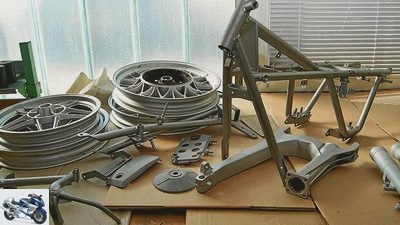
Schoch
Blank: After sandblasting, a thorough wash is due. Blasting dust and sand residues have to go down.
And there is one more restriction that must currently be observed with powder coating. In contrast to painting, only electrically conductive materials that are temperature-resistant can be powder-coated. And these are usually those made of metals. However, a solution is also emerging on this point. It will soon be possible to powder-coat even less temperature-resistant plastics.
Thorough preparation when powdering is crucial
We come to the preparation. In this point, the procedure is similar to that for painting. Here as there, the workpiece must first be freed from its old paint or coating. This is usually done by stripping. The last remaining paint and any corrosion that may be present are then removed by sandblasting. This is followed by what is known as phosphating, in which the workpiece is either immersed in a metal phosphate bath or sprayed with a metal phosphate solution. As a result, an approx. Seven to 15 µm thin metal phosphate layer forms on the surface, which bonds firmly to the base material. Depending on the process, this is an iron, manganese, nickel or zinc phosphate layer. The resulting metal phosphate layer serves as a primer for the powder coating and reliably prevents rusting underneath the coating. If the corrosion is only removed with sandblasting, the workpiece must then be thoroughly cleaned and, if necessary, thoroughly degreased.
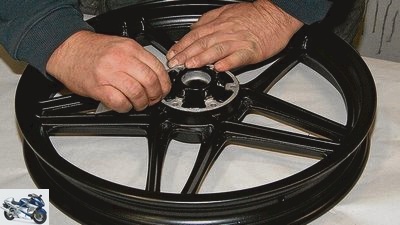
Schoch
Josip Barbir removes the masking tape while it is still hot. Now it’s soft and easy to peel off.
For permanent protection against rust, a special powder coating primer must be applied to the blasted parts before the actual color powder coating. The application of the primer is done in the same way as the actual coating with the color powder. In order for the powder to adhere to the workpiece at all, a simple but very effective trick is used, which also explains why so far only parts made of metal can be coated. The prerequisite for this is the current conductivity of the workpiece so that it can be electrically grounded in the powder coating stand.
In the compressed air powder spray gun, on the other hand, the powder is electrostatically charged. This creates an electric field of around 100 kilovolts. Result: The positively charged powder particles are attracted to the negatively charged workpiece and stick to it. At the same time, excess paint powder (overspray) is sucked off in the painting stand. Only a very even layer of powder remains on the workpiece itself. The powder-coated part is then carefully hung in a baking chamber. There the powder crosslinks at temperatures between 150 and 200 degrees Celsius to form a homogeneous layer of plastic and forms a smooth surface in around 20 minutes. After cooling, the parts can then be installed immediately without any further drying process or post-treatment.
Spatulas and fillers are taboo
And there is another thing that distinguishes powder coating from painting. No fillers or spatulas can be used for surface treatment – they would simply burn off during the stoving process. If the metal surfaces are not in perfect condition before coating, they must first be painstakingly smoothed or tinned. According to Josip Barbir, however, small bumps or scratches can also be concealed very well by multiple coatings or by applying a final clear lacquer powder coating.
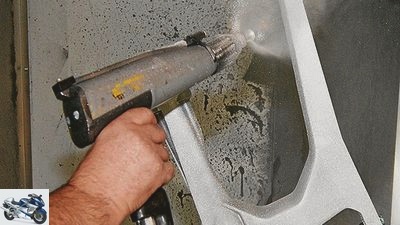
Schoch
Right: The electrostatically charged powder particles are automatically attracted to the metal.
The preparatory work also includes the careful masking or sealing of threaded holes, fits and ground connections. If this is not done, the coating has to be removed afterwards with a great deal of mechanical effort. “We have to do the masking and covering ourselves,” explains Josip Barbir, “for this you need special, temperature-resistant adhesive tapes and sealing caps. If customers send us their parts by post, we recommend precisely marking all surfaces and threads that must not be coated and discussing them with us. ”Incidentally, the size or quantity of the parts delivered does not matter. Powder coaters like Josip Barbir also accept small orders. An advantage that hobby mechanics in particular appreciate who only want to have a few parts coated.
Even if, in individual cases, powder coating requires a certain amount of extra effort in preparation compared to painting, this process is worthwhile. This is because, compared to conventional paintwork, a powder coating noticeably improves the surface properties of the treated material without forming a thicker layer than a conventional paintwork. The surfaces are permanently protected against corrosion (corrosion protection up to corrosion class C5), scratch-resistant, highly impact-resistant, chemical-resistant, weather- and abrasion-resistant. Another plus point: the powder coating is flexible. That is why this method can also be used to protect shock absorber springs from corrosion, for example.
Temperature-resistant powder coatings are now even available for parts that are subject to high heat loads, such as exhaust systems or engine components. These are based on silicone resin and can withstand temperatures of up to 550 degrees Celsius without yellowing. However, so far there are only the colors silver, gray and black as textured paint or silk gloss. If, on the other hand, you want to have parts coated that do not get hotter than 315 degrees Celsius, you can safely choose from the wide range of RAL colors.
Although powder coatings usually last much longer than paintwork, they too become unsightly at some point after many years. Then another advantage of this second skin becomes apparent, because it does not have to be sanded off with a lot of effort by hand or by machine. The removal of the old, damaged surface protection is carried out by special solutions. Within a few hours, they soften the coating so much that it can be removed with a plastic spatula without any problems and without damaging the workpiece.
The advantages and disadvantages of powder coating are therefore obvious. This method is not only suitable for chassis, frame and various engine parts, but also for small parts such as handles, panels or holders. If a permanent, mechanically highly resilient surface sealing is to be achieved here, powder coating is a recommended alternative.
Related articles
-
Buy Norton Commando parallel twins
fact 50 pictures Schoch 1/50 The rear Isolastic, on the other hand, is hidden on the subframe of the transmission. Schoch 2/50 As a result of excessive…
-
Breakable 22nd pictures Breakable 1/22 Island happiness: The slender streets of the Isle of Mull enchant especially around the highest mountain Ben More…
-
Report: This is how Austria’s police make money
archive to travel Report: This is how Austria’s police make money Report: rip off or just punishment? This is how Austria’s police make money Right line…
-
Fred Siemer Sports & scene Scene: Moto Guzzi Baker Scene: Moto Guzzi Baker The workshop of the Guzzi specialist Content of Anyone who trades with Moto…
-
Mona Pekarek 10 pictures 1/10 2/10 3/10 4/10 5/10 6/10 7/10 8/10 9/10 10/10 counselor workshop Guide to downtime and petrol Guide to downtime and petrol…
-
Sports & scene The pros: airbrush The pros: Airbrush (archive version) Brush hour If unusual motifs are desired on helmets or motorcycle parts, then the…
-
Species protection despite motorsport: off-roaders protect toads
Ferdinand Heinrich-Steige 5 pictures Ferdinand Heinrich-Steige 1/5 Motorsport and nature conservation don’t go together? The yellow-bellied toad, which…
-
to travel Aquitaine Aquitaine The bottom line Bordeaux and Brantwein ?? to get essential essences in the south of France and everywhere. Bikers also need…
-
On the smallest paths through Germany, part II
Johann to travel On the smallest paths through Germany, part II On the smallest paths through Germany, part II Is it going to the Baltic Sea somewhere??…
-
to travel Baltic states Baltic states Different than expected Beaches like on the Mediterranean, cappuccino like in Italy and magnificent buildings that…